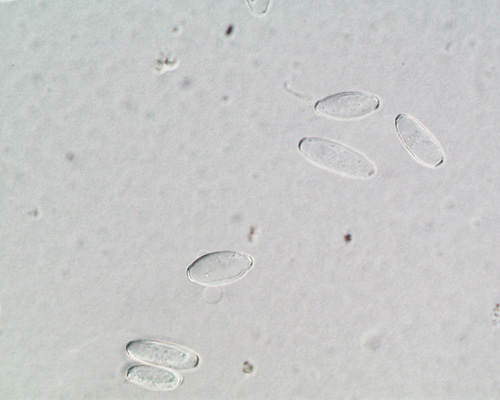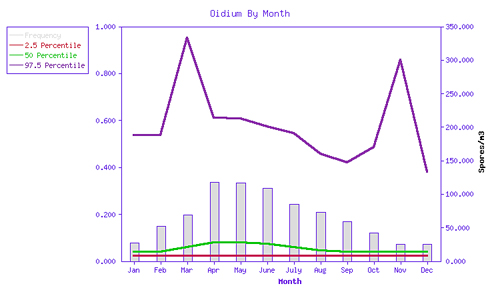I hope you're doing well and enjoying the start of spring. I also hope you'll find the following
article about Oidium by Dr. Michelle Seidl, both interesting and useful.
With best wishes,
Dave Gallup
Microorganism of the Month: Oidium
By Dr. Michelle Seidl, EMLab P&K Mycologist
Oidium gets its name from the Greek word for small egg: oidion. Historically,
the name Oidium has also been used for a variety of microbes. For example,
Oidium albicans was thought to be responsible for thrush in children. As it
turns out, this is an older name for what is now known as the yeast fungus Candida
albicans.
Oidium species are plant pathogens causing powdery mildew diseases found on
leaves, stems, flowers and fruits of living higher plants. It usually refers to the
asexual phase of the life cycle of members in the Ascomycete order Erysiphales. These
diseases are aptly named because infected portions of the plants are covered in white,
as if sprinkled with powder. This white dust is due to asexual spores and structures
belonging to Oidium. The dominant phase in the life cycle of such fungi is the
asexual stage. It was in this group of fungi where the connection was first made
between the sexual and asexual states (Tulasne & Tulasne 1861). In addition, there
exists some species of Oidium where the sexual phase is unknown.
Under the microscope, Oidium occurs singly or in short chains of 3-6,
single-celled asexual spores (arthrospores) produced by fragmentation of fungal filaments
(hyphae). Occasionally the chains can be longer, but individual spores appear cylindric,
ovoid, oblong with broadly tapered tips or barrel-shaped, with a size range of 22-46 x
10-20 micrometers.

Figure 1: Microphoto of Oidium spores from a spore trap sample.
Copyright © 2009 EMLab P&K
Oidium can be identified from all nonviable analyses, and is primarily seen in spore
trap samples. We also see Oidium in tape lifts, swabs and bulks, indicative of outside air.
No information is available regarding human health effects or toxicity. In spore traps,
Oidium spores are recovered most frequently in the spring. When we look at our
MoldRange™ data for Oidium, the highest recovery rate, of about 35%, occurs in
the spring and the lowest recovery rate, of about 8%, in the winter. See Figure 2 below.
Sometimes these spores are so abundant they can nearly fill the background of a spore trap
sample when viewed under the light microscope. This large abundance has been observed in
samples from the mid western United States and Canada. Oidium spores easily become
detached when mature and then dispersed by the wind causing a new infection on a nearby plant.
Not only do the spores act as reproductive units, but the hyphal fragments can serve to
spread the fungus as well.

Figure 2:
Frequency of detection and spore density by month for Oidium.
The gray bars represent the frequency of detection, from 0 to 1 (1=100%), graphed against the left
axis. The red, green, and purple lines represent the 2.5, 50, and 97.5 percentile airborne spore
densities, when recovered, graphed against the right hand axis.
(Source: EMLab P&K MoldRange data. Total sample
size for this graph: 39,878.)
Copyright © 2009 EMLab P&K
Powdery mildews have plagued us for centuries. Oidium species can have a fairly broad
host range and there are many plants that are susceptible to the disease. One example,
Oidium neolycopersici, is reported to attack over 60 plant species in 13 families,
particularly members of the Solanaceae (nightshade family) and Cucurbitaceae (cucumber family).
Many ornamental plants (i.e. poinsettia) and common food crops can be impacted when Oidium
is discovered, particularly in greenhouses where crops are grown year round. The grape
industry has experienced economic losses from Oidium. Grape powdery mildew was first
identified in the United States in the 1830's. In Europe, the disease reached epidemic
proportions in the 1850's. Due to its ease of dispersability, Oidium can now be found
worldwide. The fungus overwinters as sexual fruiting bodies called cleistothecia, often found
on old, infected fruit that has dropped to the ground. It can also survive the winter in the
form of hyphae or mycelium, particularly in dormant buds of the plant. When the fungus
overwinters as cleistothecia, the disease cycle begins again when the fruiting bodies break
open and release ascospores. These ascospores are also windblown to plant surfaces where
they can germinate and infect the host plant in the same manner. Environmental conditions
that favor disease development are moderate to low relative humidity and low light. Powdery
mildew does not depend so much on moisture like most fungi. For instance, it thrives in the
dryer California climate and can attack most parts of the grape plant including the fruit,
leaves, shoots, and tendrils.
In conclusion, there currently exists another, more obscure use of the term "oidium".
It is found in the basidiomycetes, referring to a type of asexual spore or a male cell
(spermatium). The smut fungi produce these types of spores. Oidia can also be produced
by mushroom-forming basidiomycetes and in this case, the hyphae break up into unicellular
sections that develop into conidia (asexual spores). Depending on the nuclear condition
of the parental mycelium, these conidia may be uninucleate, binucleate or multinucleate.
References:
Alexopoulos, C.J., C.W. Mims and M. Blackwell. 1996. Introductory Mycology. John Wiley & Sons.
University of Nebraska-Lincoln: Powdery Mildew of Grapes
Kiss, L., Takamatsu, S. and Cunnington, J. H. 2005. Molecular identification of
Oidium neolycopersici as the causal agent of the recent tomato powdery mildew epidemics
in North America. Plant Dis. 89:491-496.
Ko, W.H., S.Y. Wang, T.F. Hsieh and P.J. Ann. 2003. Effects of Sunflower Oil on
Tomato Powdery Mildew Caused by Oidium neolycopersici. J. Phytopath. 151(3): 144-148.
Tulasne, L.R. & C.C. Tulasne. 1861. Selec. Fung. Carpol. 1:194-216.